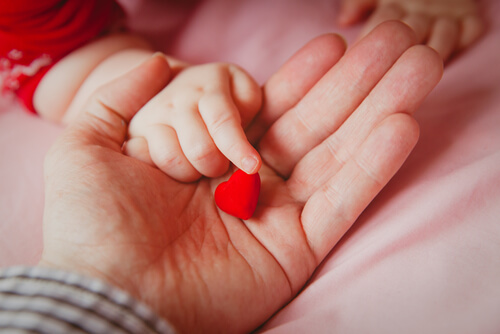What Will My Baby's Blood Type Be?


Written and verified by lawyer Francisco María García
Many people believe that a baby’s blood type has to be the same as one of their parents. Others think it’s a combination of both blood types.
For example, if the mother is O- and the father is A+, they believe the baby will either be O+ or A-.
The truth is that blood types are a little more complex than that. It’s perfectly normal for a baby not to share the same blood type as either of their parents. The laws of genetics don’t operate mechanically.
Different variables apply in the transmission of blood types and Rh. These variables need to be studied in order to more accurately determine what a baby’s blood type will be.
General aspects
Blood types depend on genetic factors which are hereditary. Traits from both parents will intervene when it comes to forming the baby’s blood type.
There are dominant and recessive genes. Dominant genes are the ones that carry more weight. They have a better chance of imposing or manifesting themselves.
In the case of blood types, the “A” and “B” are dominant genes. “O” is known as a recessive gene.
Each blood group has different characteristics. Their red blood cells and plasma are different. This gives rise to four blood groups: A, B, O and AB.
Blood types
Every human being has dominant and recessive genes. Regarding blood types, the following combinations are possible:
- Someone with the group AB has one A gene and another B gene.
- A person with group A can either be AA or AO. The dominant A gene prevails.
- If a person has the group B they could either be BB or BO. The dominant B gene prevails.
- People who have the O group have two O genes.

The combination of parents’ dominant and recessive genes is what will determine a baby’s blood type. There are 16 possible combinations. They are as follows:
IF THE FATHER IS GROUP O
* If the mother is Group A: the child will be Group A or O
* If the mother is Group B: the child will be Group B or O
* If the mother is Group AB: the child will be Group A or B
* If the mother is Group O: the child will be Group O
IF THE FATHER IS GROUP A:
* If the mother is Group A: the child will be Group A or O
* When the mother is Group B: the child will be Group O, A, B or AB
* If the mother is Group AB: the child will be Group A or B or AB
* When the mother is Group O: The child will be Group A or O
IF THE FATHER IS GROUP B:
* When the mother is Group A: the child will be Group O, A, B or AB
* If the mother is Group B: the child will be Group B or O
* When the mother is Group AB: the child will be Group A or B or AB
* If the mother is Group O: The child will be Group B or O
WHEN THE FATHER IS GROUP AB:
* If the mother is Group A: the child will be Group A, B or AB
* When the mother is Group B: the child will be Group A, B or AB
* If the mother is Group AB: the child will be Group A, B or AB
* When the mother is Group O: The child will be Group A or B
Siblings can have different blood types.

The Rh Factor
Blood sometimes contains an antigen and sometimes it doesn’t. If it has an antigen, then it’s Rh positive. If it doesn’t have an antigen, then it’s Rh negative.
As with blood types, Rh is determine by inherited genes. Positive Rh is dominant while negative Rh is recessive.
There are 9 possibilities of Rh inheritance. They are as follows:
IF THE MOTHER IS Rh-:
* If the father is Rh-: the child will be Rh-
* When the father is Rh+ (++): the child will be Rh+
* If the father is Rh+ (+-): the child will be Rh+ or Rh-
WHEN THE MOTHER IS Rh+ (++):
* If the father is Rh-: the child will be Rh+ or Rh-
* When the father is Rh+ (++): the child will be Rh+
* If the father is Rh+ (+-): the child will be Rh+ or Rh-
WHEN THE MOTHER IS Rh+ (+-):
* If the father is Rh -: the child will be Rh+ o Rh-
* When the father is Rh+ (++): the child will be Rh+
* If the father is Rh+ (+-): the child will be Rh+ or Rh-
Many people believe that a baby’s blood type has to be the same as one of their parents. Others think it’s a combination of both blood types.
For example, if the mother is O- and the father is A+, they believe the baby will either be O+ or A-.
The truth is that blood types are a little more complex than that. It’s perfectly normal for a baby not to share the same blood type as either of their parents. The laws of genetics don’t operate mechanically.
Different variables apply in the transmission of blood types and Rh. These variables need to be studied in order to more accurately determine what a baby’s blood type will be.
General aspects
Blood types depend on genetic factors which are hereditary. Traits from both parents will intervene when it comes to forming the baby’s blood type.
There are dominant and recessive genes. Dominant genes are the ones that carry more weight. They have a better chance of imposing or manifesting themselves.
In the case of blood types, the “A” and “B” are dominant genes. “O” is known as a recessive gene.
Each blood group has different characteristics. Their red blood cells and plasma are different. This gives rise to four blood groups: A, B, O and AB.
Blood types
Every human being has dominant and recessive genes. Regarding blood types, the following combinations are possible:
- Someone with the group AB has one A gene and another B gene.
- A person with group A can either be AA or AO. The dominant A gene prevails.
- If a person has the group B they could either be BB or BO. The dominant B gene prevails.
- People who have the O group have two O genes.

The combination of parents’ dominant and recessive genes is what will determine a baby’s blood type. There are 16 possible combinations. They are as follows:
IF THE FATHER IS GROUP O
* If the mother is Group A: the child will be Group A or O
* If the mother is Group B: the child will be Group B or O
* If the mother is Group AB: the child will be Group A or B
* If the mother is Group O: the child will be Group O
IF THE FATHER IS GROUP A:
* If the mother is Group A: the child will be Group A or O
* When the mother is Group B: the child will be Group O, A, B or AB
* If the mother is Group AB: the child will be Group A or B or AB
* When the mother is Group O: The child will be Group A or O
IF THE FATHER IS GROUP B:
* When the mother is Group A: the child will be Group O, A, B or AB
* If the mother is Group B: the child will be Group B or O
* When the mother is Group AB: the child will be Group A or B or AB
* If the mother is Group O: The child will be Group B or O
WHEN THE FATHER IS GROUP AB:
* If the mother is Group A: the child will be Group A, B or AB
* When the mother is Group B: the child will be Group A, B or AB
* If the mother is Group AB: the child will be Group A, B or AB
* When the mother is Group O: The child will be Group A or B
Siblings can have different blood types.

The Rh Factor
Blood sometimes contains an antigen and sometimes it doesn’t. If it has an antigen, then it’s Rh positive. If it doesn’t have an antigen, then it’s Rh negative.
As with blood types, Rh is determine by inherited genes. Positive Rh is dominant while negative Rh is recessive.
There are 9 possibilities of Rh inheritance. They are as follows:
IF THE MOTHER IS Rh-:
* If the father is Rh-: the child will be Rh-
* When the father is Rh+ (++): the child will be Rh+
* If the father is Rh+ (+-): the child will be Rh+ or Rh-
WHEN THE MOTHER IS Rh+ (++):
* If the father is Rh-: the child will be Rh+ or Rh-
* When the father is Rh+ (++): the child will be Rh+
* If the father is Rh+ (+-): the child will be Rh+ or Rh-
WHEN THE MOTHER IS Rh+ (+-):
* If the father is Rh -: the child will be Rh+ o Rh-
* When the father is Rh+ (++): the child will be Rh+
* If the father is Rh+ (+-): the child will be Rh+ or Rh-
All cited sources were thoroughly reviewed by our team to ensure their quality, reliability, currency, and validity. The bibliography of this article was considered reliable and of academic or scientific accuracy.
- Mojica Gómez, L. (2003). La prueba técnica ADN en los procesos sobre filiación. Estudios Socio-Jurídicos, 5(1), 250-265. Recuperado de http://www.scielo.org.co/scielo.php?script=sci_arttext&pid=S0124-05792003000100008.
- Morales, A. (2016). Características hereditarias en humanos. Recuperado de https://www.academia.edu/30102880/Caracter%C3%ADsticas_hereditarias_en_humanos.
- Genética. (s. f.). Recuperado 9 de enero de 2022, de Medlineplus.gov website: https://medlineplus.gov/spanish/ency/article/002048.htm.
This text is provided for informational purposes only and does not replace consultation with a professional. If in doubt, consult your specialist.








